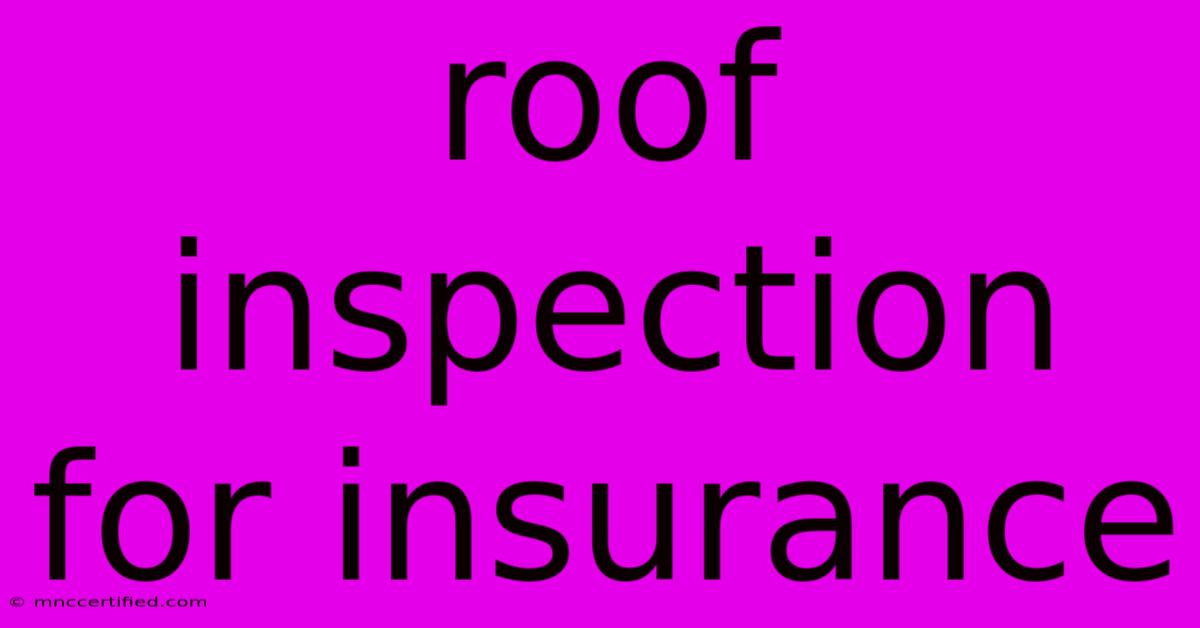Roof Inspection For Insurance

Table of Contents
Roof Inspection for Insurance: A Comprehensive Guide
Getting your roof inspected for insurance purposes can feel daunting, but understanding the process can significantly ease the burden and potentially save you thousands of dollars. This comprehensive guide will walk you through everything you need to know, from why you need an inspection to choosing the right inspector and understanding your insurance claim.
Why You Need a Roof Inspection for Insurance
Several scenarios necessitate a roof inspection for insurance purposes:
- Before purchasing a home: A pre-purchase inspection identifies potential roof problems before you commit to buying, allowing you to negotiate repairs or walk away if necessary. This protects you from unexpected and costly repairs after closing.
- After a storm or severe weather: Hail, high winds, and heavy snow can cause significant, unseen damage. A post-storm inspection documents this damage, strengthening your insurance claim. Don't delay! Many insurance policies have deadlines for reporting storm damage.
- Filing a claim for roof leaks or damage: Insurance companies require documented proof of damage before approving a claim. A professional inspection provides this crucial evidence.
- Regular maintenance: Even without visible damage, regular inspections (every few years) can identify minor issues before they escalate into major, costly repairs. This proactive approach can prevent larger, more expensive claims down the line.
Choosing the Right Roof Inspector
Finding a qualified and reputable inspector is crucial. Here's what to look for:
- Licensing and Certification: Ensure your inspector is licensed and certified in your state. Check for affiliations with reputable organizations like the International Association of Certified Home Inspectors (InterNACHI).
- Experience: Look for inspectors with significant experience inspecting roofs, ideally with a proven track record.
- Insurance: Confirm the inspector carries liability insurance to protect you in case of accidents.
- Reviews and Testimonials: Read online reviews and testimonials to gauge the inspector's professionalism, thoroughness, and communication skills.
- Detailed Report: The inspector should provide a detailed written report outlining their findings, including photos and recommendations. A thorough report is vital for your insurance claim.
What to Expect During a Roof Inspection
A thorough roof inspection typically involves:
- Visual inspection: The inspector will examine the roof from the ground and, if safely accessible, from the roof itself. They'll look for signs of damage, such as missing shingles, cracks, leaks, and deterioration.
- Assessment of materials: The type of roofing material will be identified and assessed for its condition and expected lifespan.
- Flashing inspection: Inspectors pay close attention to flashing—the metal pieces that seal around chimneys, vents, and other penetrations—as these are common leak points.
- Gutter and downspout inspection: Proper drainage is essential for roof health. The inspector will check for blockages and damage.
- Underlayment evaluation (if accessible): The underlayment, a waterproof layer beneath the shingles, will be checked for damage if accessible.
Understanding Your Insurance Claim
Once you have a comprehensive inspection report documenting the damage, you can file a claim with your insurance company. Be prepared to:
- Provide detailed information: This includes the date of damage, a description of the damage, and the cost of repairs (backed by the inspector's report).
- Submit supporting documentation: This includes the inspection report, photos of the damage, and any other relevant documents.
- Communicate with your insurer: Be proactive in your communication and respond promptly to any requests for information.
SEO Keywords for this Article
This article targets a variety of keywords, including: roof inspection, insurance claim, roof damage, storm damage, home inspection, pre-purchase inspection, roof repair, insurance claim process, choosing a roof inspector, licensed inspector, certified inspector, hail damage, wind damage, snow damage, roof leak, flashing, underlayment, gutter inspection, downspout inspection, and various location-specific keywords (e.g., "roof inspection [city name]").
Conclusion
A thorough roof inspection is a crucial step in protecting your investment and ensuring a smooth insurance claim process. By understanding the process and choosing a qualified inspector, you can navigate this often-complex situation with confidence. Remember to act quickly after a storm and maintain proactive communication with your insurance provider. This proactive approach will save you time, money, and a significant amount of stress in the long run.

Thank you for visiting our website wich cover about Roof Inspection For Insurance. We hope the information provided has been useful to you. Feel free to contact us if you have any questions or need further assistance. See you next time and dont miss to bookmark.
Featured Posts
-
Trader Joes Thanksgiving Hours 2024
Nov 28, 2024
-
Rain Hit Day 1 Sa 80 4 Vs Sri Lanka
Nov 28, 2024
-
Journalist On Liverpool Defender Injury
Nov 28, 2024
-
United Home Insurance Company
Nov 28, 2024
-
How Much Is 59k A Year Hourly
Nov 28, 2024